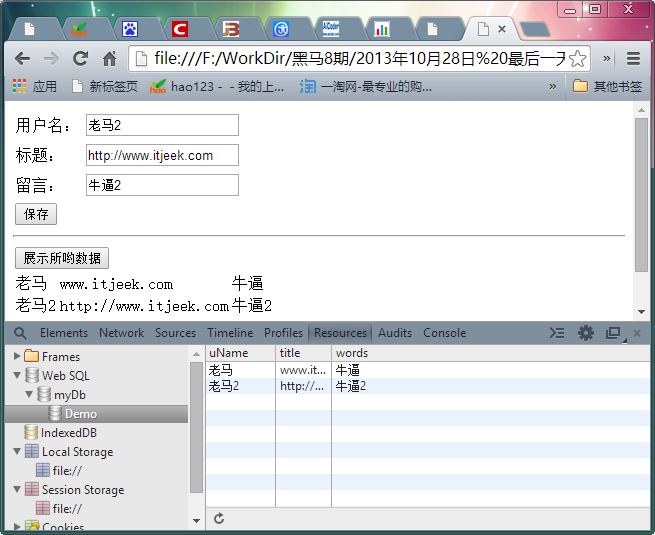Is local database a new feature of HTML5?
Local database is a new feature of html5. Html5 provides a browser-side database support, allowing developers to create a local database on the browser side directly through the JS API, and supports standard SQL CRUD operations, making offline web applications more convenient to store structured data. .

The operating environment of this tutorial: Windows 7 system, HTML5 version, Dell G3 computer.
Although Html5 has provided powerful localStorage and sessionStorage, both of them can only provide data for storing simple data structures, and are powerless for complex web application data. What’s incredible is that Html5 provides a database support on the browser side, allowing us to create a local database on the browser side directly through the JS API, and supports standard SQL CRUD operations, making offline web applications more convenient to store structures. ized data. Next, we will introduce the relevant APIs and usage of local data.
The most basic steps to operate a local database are:
- The first step: openDatabase method: Create an object to access the database.
- Step 2: Use the database access object created in the first step to execute the transaction method. Through this method, you can set an event response method to start the transaction successfully. In the event response method, you can execute SQL.
- Step 3: Execute the query through the executeSql method. Of course, the query can be: CRUD.
Next, we will introduce the parameters and usage of the relevant methods.
(1) openDatabase method:
//Demo:获取或者创建一个数据库,如果数据库不存在那么创建之
var dataBase = openDatabase("student", "1.0", "学生表", 1024 * 1024, function () { });The openDatabase method opens an existing database. If the database does not exist, it can also create a database. The meanings of several parameters are:
- 1, database name.
- 2. The version number of the database. Currently, 1.0 is enough. Of course, you don’t need to fill it in;
- 3. The description of the database.
- 4, set the size of the allocated database (unit is kb).
- 5, callback function (can be omitted).
- Create the database when calling for the first time, and then establish the connection.
(2) The db.transaction method can set a callback function. This function can accept a parameter that is the object of the transaction we started. Then the Sql script can be executed through this object, which can be combined with the following steps.
(3) Execute the query through the executeSql method.
ts.executeSql(sqlQuery,[value1,value2..],dataHandler,errorHandler)
Parameter description:
- qlQuery: SQL statement that needs to be executed specifically, which can be create, select, update, delete;
- value1,value2..] : An array of all parameters used in the sql statement. In the executeSql method, first replace the parameters to be used in the s> statement with "?", and then form an array of these parameters and place them in the second parameter.
- ataHandler: The callback function called when the execution is successful, through which the query result set can be obtained;
- 4, errorHandler: The callback function called when the execution fails;
The following It is a comprehensive example, you can take a look:
<head>
<script src="Scripts/jquery-1.5.1.js" type="text/javascript"></script>
<script type="text/javascript">
function initDatabase() {
var db = getCurrentDb();//初始化数据库
if(!db) {alert("您的浏览器不支持HTML5本地数据库");return;}
db.transaction(function (trans) {//启动一个事务,并设置回调函数
//执行创建表的Sql脚本
trans.executeSql("create table if not exists Demo(uName text null,title text null,words text null)", [], function (trans, result) {
}, function (trans, message) {//消息的回调函数alert(message);});
}, function (trans, result) {
}, function (trans, message) {
});
}
$(function () {//页面加载完成后绑定页面按钮的点击事件
initDatabase();
$("#btnSave").click(function () {
var txtName = $("#txtName").val();
var txtTitle = $("#txtTitle").val();
var txtWords = $("#txtWords").val();
var db = getCurrentDb();
//执行sql脚本,插入数据
db.transaction(function (trans) {
trans.executeSql("insert into Demo(uName,title,words) values(?,?,?) ", [txtName, txtTitle, txtWords], function (ts, data) {
}, function (ts, message) {
alert(message);
});
});
showAllTheData();
});
});
function getCurrentDb() {
//打开数据库,或者直接连接数据库参数:数据库名称,版本,概述,大小
//如果数据库不存在那么创建之
var db = openDatabase("myDb", "1.0", "it's to save demo data!", 1024 * 1024); ;
return db;
}
//显示所有数据库中的数据到页面上去
function showAllTheData() {
$("#tblData").empty();
var db = getCurrentDb();
db.transaction(function (trans) {
trans.executeSql("select * from Demo ", [], function (ts, data) {
if (data) {
for (var i = 0; i < data.rows.length; i++) {
appendDataToTable(data.rows.item(i));//获取某行数据的json对象
}
}
}, function (ts, message) {alert(message);var tst = message;});
});
}
function appendDataToTable(data) {//将数据展示到表格里面
//uName,title,words
var txtName = data.uName;
var txtTitle = data.title;
var words = data.words;
var strHtml = "";
strHtml += "<tr>";
strHtml += "<td>"+txtName+"</td>";
strHtml += "<td>" + txtTitle + "</td>";
strHtml += "<td>" + words + "</td>";
strHtml += "</tr>";
$("#tblData").append(strHtml);
}
</script>
</head>
<body>
<table>
<tr>
<td>用户名:</td>
<td><input type="text" name="txtName" id="txtName" required/></td>
</tr>
<tr>
<td>标题:</td>
<td><input type="text" name="txtTitle" id="txtTitle" required/></td>
</tr>
<tr>
<td>留言:</td>
<td><input type="text" name="txtWords" id="txtWords" required/></td>
</tr>
</table>
<input type="button" value="保存" id="btnSave"/>
<hr/>
<input type="button" value="展示所哟数据" onclick="showAllTheData();"/>
<table id="tblData">
</table>
</body>
</html>The execution effect is as shown in the figure:

Related recommendations: "html video Tutorial》
The above is the detailed content of Is local database a new feature of HTML5?. For more information, please follow other related articles on the PHP Chinese website!

Hot AI Tools

Undresser.AI Undress
AI-powered app for creating realistic nude photos

AI Clothes Remover
Online AI tool for removing clothes from photos.

Undress AI Tool
Undress images for free

Clothoff.io
AI clothes remover

Video Face Swap
Swap faces in any video effortlessly with our completely free AI face swap tool!

Hot Article

Hot Tools

Notepad++7.3.1
Easy-to-use and free code editor

SublimeText3 Chinese version
Chinese version, very easy to use

Zend Studio 13.0.1
Powerful PHP integrated development environment

Dreamweaver CS6
Visual web development tools

SublimeText3 Mac version
God-level code editing software (SublimeText3)

Hot Topics
 1668
1668
 14
14
 1426
1426
 52
52
 1328
1328
 25
25
 1273
1273
 29
29
 1255
1255
 24
24
 React's Ecosystem: Libraries, Tools, and Best Practices
Apr 18, 2025 am 12:23 AM
React's Ecosystem: Libraries, Tools, and Best Practices
Apr 18, 2025 am 12:23 AM
The React ecosystem includes state management libraries (such as Redux), routing libraries (such as ReactRouter), UI component libraries (such as Material-UI), testing tools (such as Jest), and building tools (such as Webpack). These tools work together to help developers develop and maintain applications efficiently, improve code quality and development efficiency.
 The Future of React: Trends and Innovations in Web Development
Apr 19, 2025 am 12:22 AM
The Future of React: Trends and Innovations in Web Development
Apr 19, 2025 am 12:22 AM
React's future will focus on the ultimate in component development, performance optimization and deep integration with other technology stacks. 1) React will further simplify the creation and management of components and promote the ultimate in component development. 2) Performance optimization will become the focus, especially in large applications. 3) React will be deeply integrated with technologies such as GraphQL and TypeScript to improve the development experience.
 React: The Power of a JavaScript Library for Web Development
Apr 18, 2025 am 12:25 AM
React: The Power of a JavaScript Library for Web Development
Apr 18, 2025 am 12:25 AM
React is a JavaScript library developed by Meta for building user interfaces, with its core being component development and virtual DOM technology. 1. Component and state management: React manages state through components (functions or classes) and Hooks (such as useState), improving code reusability and maintenance. 2. Virtual DOM and performance optimization: Through virtual DOM, React efficiently updates the real DOM to improve performance. 3. Life cycle and Hooks: Hooks (such as useEffect) allow function components to manage life cycles and perform side-effect operations. 4. Usage example: From basic HelloWorld components to advanced global state management (useContext and
 Frontend Development with React: Advantages and Techniques
Apr 17, 2025 am 12:25 AM
Frontend Development with React: Advantages and Techniques
Apr 17, 2025 am 12:25 AM
The advantages of React are its flexibility and efficiency, which are reflected in: 1) Component-based design improves code reusability; 2) Virtual DOM technology optimizes performance, especially when handling large amounts of data updates; 3) The rich ecosystem provides a large number of third-party libraries and tools. By understanding how React works and uses examples, you can master its core concepts and best practices to build an efficient, maintainable user interface.
 React vs. Backend Frameworks: A Comparison
Apr 13, 2025 am 12:06 AM
React vs. Backend Frameworks: A Comparison
Apr 13, 2025 am 12:06 AM
React is a front-end framework for building user interfaces; a back-end framework is used to build server-side applications. React provides componentized and efficient UI updates, and the backend framework provides a complete backend service solution. When choosing a technology stack, project requirements, team skills, and scalability should be considered.
 Understanding React's Primary Function: The Frontend Perspective
Apr 18, 2025 am 12:15 AM
Understanding React's Primary Function: The Frontend Perspective
Apr 18, 2025 am 12:15 AM
React's main functions include componentized thinking, state management and virtual DOM. 1) The idea of componentization allows splitting the UI into reusable parts to improve code readability and maintainability. 2) State management manages dynamic data through state and props, and changes trigger UI updates. 3) Virtual DOM optimization performance, update the UI through the calculation of the minimum operation of DOM replica in memory.
 React and Frontend Development: A Comprehensive Overview
Apr 18, 2025 am 12:23 AM
React and Frontend Development: A Comprehensive Overview
Apr 18, 2025 am 12:23 AM
React is a JavaScript library developed by Facebook for building user interfaces. 1. It adopts componentized and virtual DOM technology to improve the efficiency and performance of UI development. 2. The core concepts of React include componentization, state management (such as useState and useEffect) and the working principle of virtual DOM. 3. In practical applications, React supports from basic component rendering to advanced asynchronous data processing. 4. Common errors such as forgetting to add key attributes or incorrect status updates can be debugged through ReactDevTools and logs. 5. Performance optimization and best practices include using React.memo, code segmentation and keeping code readable and maintaining dependability
 The Power of React in HTML: Modern Web Development
Apr 18, 2025 am 12:22 AM
The Power of React in HTML: Modern Web Development
Apr 18, 2025 am 12:22 AM
The application of React in HTML improves the efficiency and flexibility of web development through componentization and virtual DOM. 1) React componentization idea breaks down the UI into reusable units to simplify management. 2) Virtual DOM optimization performance, minimize DOM operations through diffing algorithm. 3) JSX syntax allows writing HTML in JavaScript to improve development efficiency. 4) Use the useState hook to manage state and realize dynamic content updates. 5) Optimization strategies include using React.memo and useCallback to reduce unnecessary rendering.




